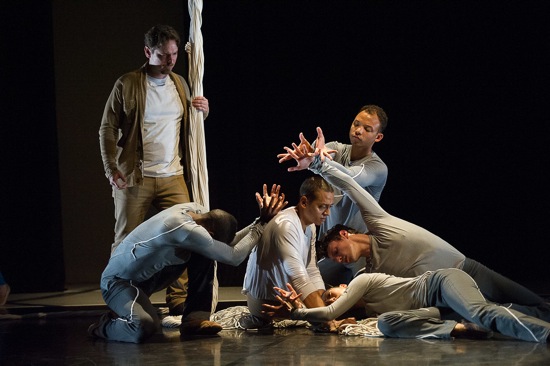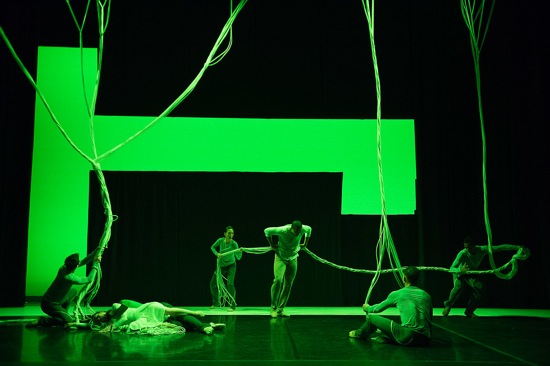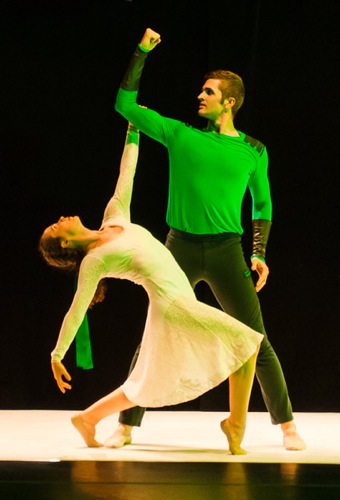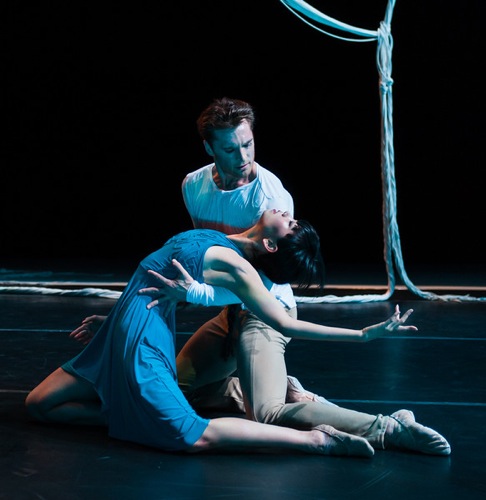Jessica Lang Dance in The Wanderer at Jacob’s Pillow July 29-August 9.

Jessica Lang’s The Wanderer. Standing; baritone John Boehr. On floor (L to R): Randy Castillo, Clifton Brown, Jammie Walker, John Harnage, and Julie Fiorenza (lying down). Photo: Christopher Duggan
Die schöne Mullerin, a suite of Romantic-era poems by Wilhelm Müller, set to ravishing music by his friend Franz Schubert, conjures up visions of a mystical natural world in which a swift-moving brook urges a wandering miller to follow its course—one that brings him to a mill. What does this rushing water have in mind? Is it a helpful guide, sensing the itinerant miller needs a job? Is it a go-between, urging the hero toward the mill owner’s beautiful daughter? And finally, when the girl breaks his heart by preferring a hunter, does the brook (surely now a she), offer him her fatal embrace in order to soothe him into suicide or because she desires to have him for her own? Who can tell?
I missed seeing Jessica Lang’s dance set to that music at BAM last year, but was extremely happy to see/hear The Wanderer at Jacob’s Pillow—not simply because the dance was choreographed during residencies at the Pillow and looks especially handsome in the wooden interior of the Doris Duke Theatre, but because the audience has walked to it through a fever of summer greenery. A green ribbon is an innocent catalyst in Schubert’s lieder cycle, and Müller’s text brims with allusions to nature and its cycle of birth and death.
The production is an extremely handsome one, and eight skilled dancers (four of whom, like Lang, are Juilliard graduates) perform the choreography beautifully. Baritone Steven Labrie (John Boehr sings on other days) and pianist Tyson Deaton endow the songs with the melting, rippling beauty they require, and Labrie at times moves among the dancers and sings to them.

The world turns green in Jessica Lang’s The Wanderer. (L to R): John Harnage, Laura Mead and Milan Misko (sleeping), Julie Fiorenza, Clifton Brown, Jammie Walker, Randy Castillo. Photo: Christopher Duggan
Mimi Lien’s set is a marvel. A white path extends along three sides of the black floor. Four white trees bare of leaves stand about, stretching their branches upward. Before long, you realize that the trees are made entirely of string. What looks somewhat like a huge, square-cornered white key seems suspended horizontally across the back wall (another illusion; it’s the surrounding black areas that are cut out, and performers appear in what stands for the miller’s daughter’s second-floor room or behind the black barrier that could suggest a balcony wall). Since she is so very fond of green, when the Hunter (Milan Misko) appears and precipitates the tragedy, lighting designer Nicole Pearce turns the white areas at the back green in sympathy.
Lang deserves praise both for her skill in illustrating Schubert’s song cycle through dance and for moving it away from literal imagery to designs that allude in more abstract ways to the images in the poems. Clifton Brown (who alternates in the role of The Wanderer with Kirk Henning) marvelously conveys the roving miller’s zest for beauty and a free life, his adoration of the mill owner’s daughter (Laura Mead), and his puzzlement (and apparent helplessness) when the strutting, self-satisfied Hunter appeals to the woman he thought he’d won. Costume designer Bradon McDonald has dressed the interloper in a green shirt. This not only links him with the green ribbon on The Wanderer’s knapsack, which she craves and is given; it tells us and her that the Hunter is of the wild forest, not of the unchanging mill where she in her flour-white dress spends her days.

Laura Mead as The Girl and Milan Misko as The Hunter in Jessica Lang’s The Wanderer. Photo: Takao Komaru
One of Lang’s accomplishments in The Wanderer is her shape-shifting approach to four dancers identified as The Others, who never leave the scene. Müller’s text gave her that possibility. Speaking of the untiring mill wheel, the poem goes on to say: The stones themselves, though they are heavy,/The stones!/They join the dance’s merry round,/And gladly would move faster!
Sometimes Randy Castillo, John Harnage, Eve Jacobs (alternating with Julia Fiorenza), and Jammie Walker are the mill owner’s assistants with whom Brown works and roisters. At other times, crouched down and packed together, they evoke those turning millstones. Leaping along, they follow the bubbling course of the Brook (Kana Kimura). But they are also stagehands like those in Kabuki theater. They uncoil the nests of strings around the base of each tree and range them along the floor like river banks, or turn them into jump ropes to challenge the hero. Various of the four tie two trees together into one bigger one; in the end, all the trees have merged. Also, when Castillo and Jacobs dance beside Brown and Mead, they seem to represent the couple’s other selves.
The Brook is one of the piece’s attractions, but also one of its problems. Wearing a beautiful, deep blue gown that swirls around her, Kimura is a sight to see. Lean and lithe, she flows into her dancing, which—as for all the cast—is balletic without being classical and ventures into freer movements, Stretching her limbs in swooping arabesques and making “follow me!” and “this way!” gestures, Kimura clearly lures The Wanderer on. And in the end, she does engulf him. Müller gave this body of water intentions, and Schubert made it ripple in his music. Obviously Lang had to embody it in a female dancer. But Kimura is more an updated naiad—a water nymph—than a bubbling, rolling-on current. Her movements, fluid though they are, are those of a possessive but inarticulate woman, and it is as a woman that The Wanderer treats her when they come together.
It’s also difficult for narrative dance to achieve the porousness of poetry and music. The Wanderer glimpses The Girl and The Hunter together at a distance, and it tears him apart. But, he is sometimes only a few feet away from them onstage, so you wonder why he doesn’t confront his rival (he can’t anyway, because the poem contains no such scene). Yet, even though the singer moves among the dancers, we easily accept that he is outside the tale he is telling. He stands almost touching them, and they don’t see him.
Despite such cavils, I think that Lang and all her collaborators have created something appealing and visually lovely. Everything about The Wanderer seems true and mostly heartfelt (especially evident in Brown’s performing), if only occasionally resonant of the deeper matters that lurk in the music and the alluring, often dangerous images of a fertile, mystical nature that so enthralled 19th-century artists.


I am wondering Deborah if you think Noguchi influenced the use of the threads that are part of Lang’s choreography. Thank you as usual for your eloquent, not to mention vivid, writing.
I’m so glad you enjoyed Lang’s Wanderer, which I also saw the other night. I’ve now seen three works by Lang (one she made for the Birmingham Royal, another for Glimmerglass Opera), and I think she’s the real deal. She has a lyrical imagination that gives her a fluid, allusive approach to narrative, but her gestural vocabulary itself is so lovely, supple, and varied that you almost don’t care whether there’s a narrative or not. At the same time, she’s alert to human psychology, and one thing the Wanderer gets across beautifully is the idea that we can’t control our feelings, much less those of another to whom our feelings are directed. My take on The Wanderer will be appearing in an upcoming Hopkins Review. Thank you so much, Deborah!